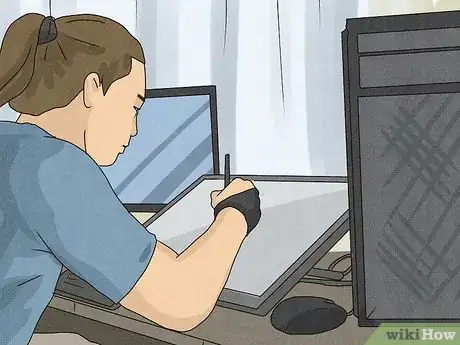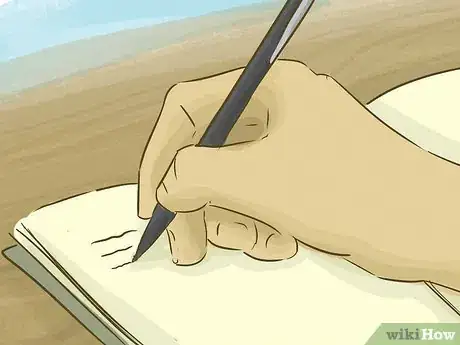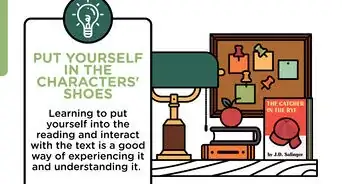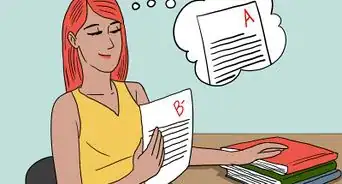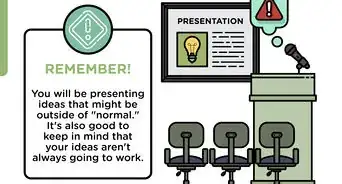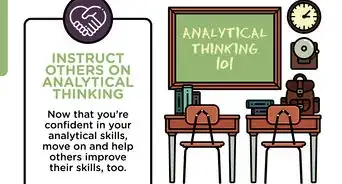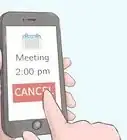This article was co-authored by Guy Reichard. Guy Reichard is an Executive Life Coach and the Founder of HeartRich Coaching & Training, a professional life coaching and inner leadership training provider based in Toronto, Ontario, Canada. He works with people to create more meaning, purpose, well-being, and fulfillment in their lives. Guy has over 10 years of personal growth coaching and resilience training experience, helping clients enhance and transform their inner worlds, so they can be a more positive and powerful influence on those they love and lead. He is an Adler Certified Professional Coach (ACPC), and is accredited by the International Coach Federation. He earned a BA in Psychology from York University in 1997 and a Master of Business Administration (MBA) from York University in 2000.
This article has been viewed 33,026 times.
We have all been in situations where we have been asked a question and our mind has gone blank. Fortunately, you can train yourself to think on your feet to improve the way you perform under pressure both at work and in your social life. Learning how to think on your feet will others that you're an intelligent employee and a skilled problem solver. We'll give you the rundown on concrete tips you can use to get better at thinking on your feet.
Steps
Thinking Fast in Social Situations and at Work
-
1Think ahead about the questions you might be asked. A common acronym “FAQ,” or “frequently asked questions,” shows that there are a common set of questions for any situation. Prepare for these FAQs if you know you're going into a situation where you may have to think quickly.
- At work, you might consider what questions will be asked at a meeting on a current project or about employees.
- During an interview, you may be asked common questions like: “Where do you see yourself in five year” or “What do you feel are your biggest challenges.”[1]
- At family gathers, you may be asked about your job or home life.
-
2Stall for time. If you need to gather your thoughts before you give your answer, there are a few ways that you can articulate your thoughts.
- Repeat the question out loud to help jog your memory and help you think of an answer.
- Narrow the focus to a conversation or answer that you do know a lot about. This might helpful if you are unsure how to answer or react to the whole problem at hand.
Advertisement -
3Improvise. Conversation is not scripted. While you should be mindful with what you say, you should also improvise to continue conversation. You can try a few technique that actors use onstage to keep a scene going.
- Yes...and technique. If you are worried about continuing a conversation, try not to answer questions with a “yes” or a “no.” An example of this might be -- Question: “Did you enjoy your vacation to Italy?” Answer: “Yes...and we got to eat some really great food in Rome!” This takes a simple yes/no question and turns it into more an active conversation.[2]
- Go with your gut. While second-guessing may come in handy in some situations, partaking in a conversation may not be the best area. Sometimes, it is best to go with your gut and say what is on your mind. This may not be the best solution for more loquacious speakers, but may work if you find yourself thinking too much before speaking.
-
4Be positive. If you start a conversation with a compliment, or by saying something nice, your audience will be more likely to listen to what you have to say. For example:
- ”Question: What did you think about the movie?” Answer: “I really liked the music. Man, I really enjoy watching movies with someone who understands my love for Sci-Fi soundtracks!”
- ”Question: Do you think this new implementation will work for our clients?” “Answer: “I don't think it is quite ready for launch, but I think the development team did a good job with the login code.”
-
5Listen. Thinking on your feet may not necessarily be giving an answer quickly. To come up with a comprehensive answer to really impress your audience, you should actively listen to what they have to say.[3]
- When someone is speaking, try and pay attention to not only what they are saying it but how they are saying it. This includes body language and intonation. This will give you clues on the best way you should respond. For example: Is the person with you very frustrated? How might you respond to not escalate a situation?
- If you find yourself having trouble focusing on someone when they speak, try and keep eye-contact with them or look at their face. This will help you focus on what the person is saying and make you appear attentive.
Solving Problems
-
1Involve others. Life is not often a solitary journey. If you have to think on your feet about a project, include others to help think along with you. After all, there is an old adage of: “Two heads are better than one.”
- Always be polite about asking others to help. You want them to come into a project with an open mind and a willingness to think of new solutions.
- Try not to subject others to your conclusions or opinions. You want others to come in with a different and new perspective, so that you may see all the options before making a decision.
-
2Stay calm. Stress can make you forget to do things or not react appropriately to a situation. Try and stay calm in situations where you know you will need to be thinking on your feet.[4]
- Try stress relieving methods like yoga or meditations to help with lingering stress in your life.
- Count to ten or twenty if you find yourself getting frustrated or stressed in a situation. This might help calm you down.
- Try breathing exercises. Breathing exercises are not only designed to help you with your overall health, but they can help calm you down as well.[5] Doing exercises like “pursed lip breathing” (breathing deeply through pursed lips and exhaling) or “belly breathing” (taking a deep breath from your stomach and exhaling) can calm you down in a stressful situation.
-
3Stay active. Studies have shown that students working at standing desks are both quicker and more accurate in answering questions.[6] Taking frequent breaks from work to stand up and move around may actually help you think quicker; and, you will be doing so while literally being on your feet!
-
4Keep an open mind. Try not to go into a situation with a prepared answer or decision. This will turn your mind off to new possibilities or avenues. Keep an open mind and be receptive to new ideas. [7]
- Try to not let personal beliefs or answers cloud an objective judgement. For example, if you are at work and get asked a tough question on a project, try to answer with facts instead of feelings.
Analyzing Your Thinking Patterns
-
1Consider how you think. Introverts and extroverts think differently. Extroverts are more likely to “Do, Think, Do” pattern, while their introverted counterparts take more time to think before taking an action. No way is better than the other, but knowing how you personally think will help you streamline your own thinking patterns.
-
2Practice self-reflection and self-awareness. Self-awareness has been tied to leadership, and leadership often reflects a person's ability to think on one's feet. You can become more self-aware by practicing self-reflection techniques. Being more self-aware will help you better understand the environment around you, and make it easier to think of solutions or answer more quickly.[8] How to Self Reflect
- Use a journal to write down your thoughts, feelings and reactions to mental stimuli throughout your day.
- Understand how you solve problems by considering each step you take
- Think about what emotions you feel during day to day tasks (I.e. Do you feel frustration while performing a specific task at work?) Think about why you might be feeling that emotion.
-
3Ask questions. To more effectively think on your feet, you need to gather as much information as possible about the situation you are in. One simple way of doing this is by asking questions about the task at hand. This will help you compile more information and help to educate you on a particular situation. Ask things like:
- “I hear that you want a report written about this client. What are you concerned about, specifically?”
- ”You seem to be asking me about a project we finished last week. What was it that you wanted to know about it?”
- ”What do you mean by what you said?” (This can help you get not only a clearer understanding of what was said, but also give the speaker to think about what s/he wants from you).
-
4Be skeptical. By being critical of presented information, you are more likely to pick up on weak points of a situation. This may help you to see solutions quicker.
- Don't take everything at face value. If you are asked to do a specific task or answer a specific question, try to gather as much facts about the situation before you make a decision. While the goal is to think quickly and on your feet, you still want to be accurate and understanding.
- If you are asked to think on your feet by giving an answer to something that seems to be too good to be true (for example, a sale) be skeptical! It may very well be too good to be true!
Expert Q&A
-
QuestionHow can I steady my mind so I don't lose my cool?
 Guy ReichardGuy Reichard is an Executive Life Coach and the Founder of HeartRich Coaching & Training, a professional life coaching and inner leadership training provider based in Toronto, Ontario, Canada. He works with people to create more meaning, purpose, well-being, and fulfillment in their lives. Guy has over 10 years of personal growth coaching and resilience training experience, helping clients enhance and transform their inner worlds, so they can be a more positive and powerful influence on those they love and lead. He is an Adler Certified Professional Coach (ACPC), and is accredited by the International Coach Federation. He earned a BA in Psychology from York University in 1997 and a Master of Business Administration (MBA) from York University in 2000.
Guy ReichardGuy Reichard is an Executive Life Coach and the Founder of HeartRich Coaching & Training, a professional life coaching and inner leadership training provider based in Toronto, Ontario, Canada. He works with people to create more meaning, purpose, well-being, and fulfillment in their lives. Guy has over 10 years of personal growth coaching and resilience training experience, helping clients enhance and transform their inner worlds, so they can be a more positive and powerful influence on those they love and lead. He is an Adler Certified Professional Coach (ACPC), and is accredited by the International Coach Federation. He earned a BA in Psychology from York University in 1997 and a Master of Business Administration (MBA) from York University in 2000.
Executive Life Coach Meditate. Practice self-regulation. Expose yourself to more challenges to get some practice thinking on your feet.
Meditate. Practice self-regulation. Expose yourself to more challenges to get some practice thinking on your feet. -
QuestionWhat if I get anxious when I'm under pressure?
 Guy ReichardGuy Reichard is an Executive Life Coach and the Founder of HeartRich Coaching & Training, a professional life coaching and inner leadership training provider based in Toronto, Ontario, Canada. He works with people to create more meaning, purpose, well-being, and fulfillment in their lives. Guy has over 10 years of personal growth coaching and resilience training experience, helping clients enhance and transform their inner worlds, so they can be a more positive and powerful influence on those they love and lead. He is an Adler Certified Professional Coach (ACPC), and is accredited by the International Coach Federation. He earned a BA in Psychology from York University in 1997 and a Master of Business Administration (MBA) from York University in 2000.
Guy ReichardGuy Reichard is an Executive Life Coach and the Founder of HeartRich Coaching & Training, a professional life coaching and inner leadership training provider based in Toronto, Ontario, Canada. He works with people to create more meaning, purpose, well-being, and fulfillment in their lives. Guy has over 10 years of personal growth coaching and resilience training experience, helping clients enhance and transform their inner worlds, so they can be a more positive and powerful influence on those they love and lead. He is an Adler Certified Professional Coach (ACPC), and is accredited by the International Coach Federation. He earned a BA in Psychology from York University in 1997 and a Master of Business Administration (MBA) from York University in 2000.
Executive Life Coach Try reframing the meaning of pressure. Start approaching it as opportunity to improve yourself instead of a feeling that you need to avoid.
Try reframing the meaning of pressure. Start approaching it as opportunity to improve yourself instead of a feeling that you need to avoid.
References
- ↑ http://www.job-hunt.org/recruiters/smart-job-interview-answers.shtml
- ↑ http://www.cnn.com/2008/LIVING/08/12/rs.how.to.think.on.feet/
- ↑ Guy Reichard. Executive Life Coach. Expert Interview. 19 March 2020.
- ↑ Guy Reichard. Executive Life Coach. Expert Interview. 19 March 2020.
- ↑ http://www.copdfoundation.org/What-is-COPD/Living-with-COPD/Breathing-Techniques.aspx
- ↑ http://neurosciencenews.com/standing-classroom-engagement-psychology-1993/
- ↑ http://www.forbes.com/sites/glennllopis/2013/11/04/the-4-most-effective-ways-leaders-solve-problems/
- ↑ Guy Reichard. Executive Life Coach. Expert Interview. 19 March 2020.








